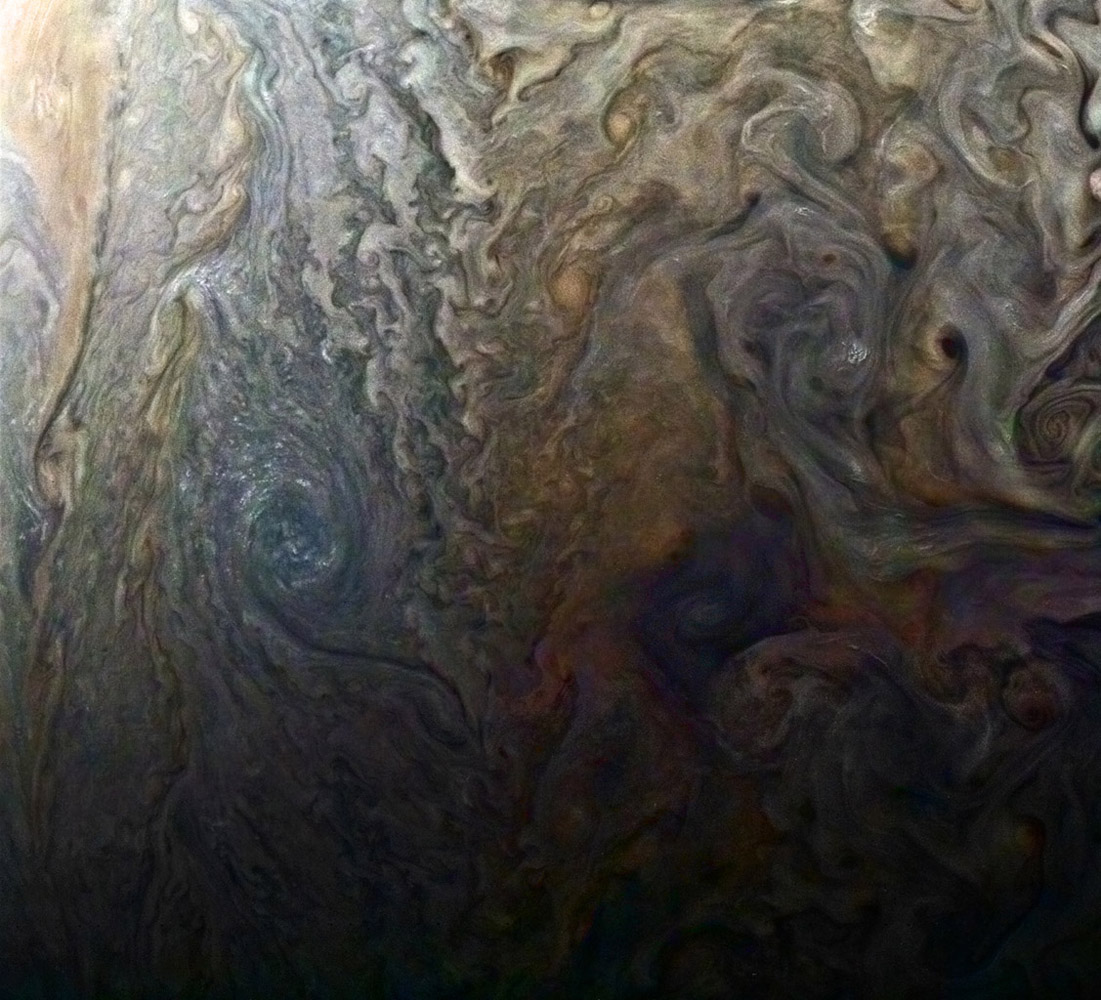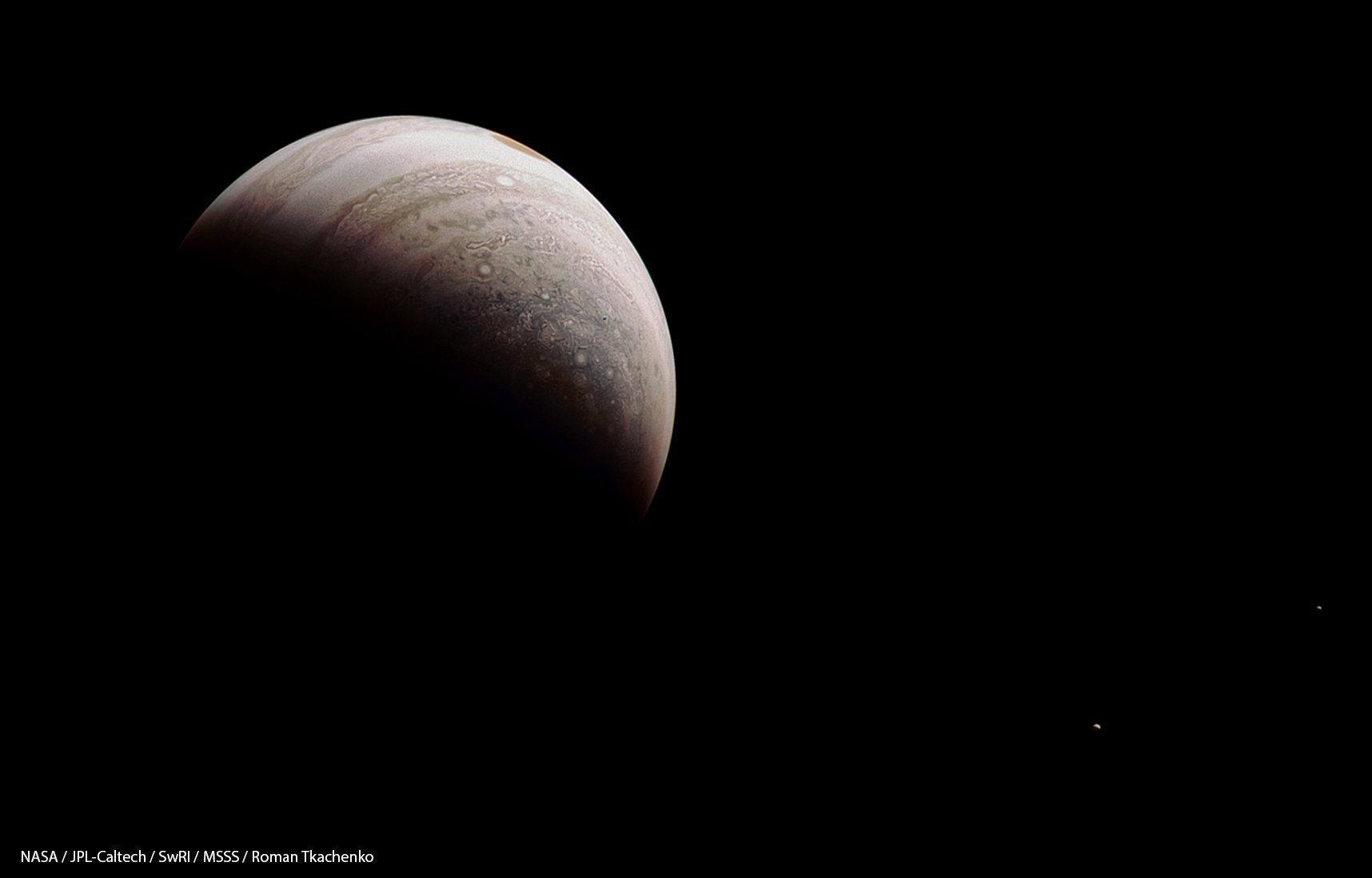
Crescent Jupiter, with two of its moons, Europa and Io, as seen by Juno during its fifth flyby on March 27, 2017. This is a view never possible from Earth. Image Credit: NASA/JPL-Caltech/SwRI/MSSS/Roman Tkachenko
NASA’s Juno spacecraft has successfully completed its fifth close flyby of Jupiter, gathering more scientific data and sending back more incredible images of the largest planet in our Solar System. Juno, the first mission dedicated to Jupiter since Galileo, has been helping scientists to understand some of the long-standing mysteries about the largest planet in our Solar System.
Juno’s closest approach during the flyby occurred on Monday, March 27, at 1:52 a.m. PDT (4:52 a.m. EDT, 8:52 UTC). All of the spacecraft’s science instruments were operating during the flyby, and now scientists back on Earth will have even more data to go through from the mission so far, as well as, of course, more stunning images.
During each close flyby, Juno can see Jupiter’s clouds in incredible detail, revealing intricate and complex formations, especially at the planet’s poles. Indeed they look like works of art. While Jupiter’s mid-latitude and equatorial regions are dominated by broad bands of clouds, the poles features many circular cyclones and other cloud formations. As seen from above the poles, Jupiter almost looks like a completely different planet. At closest approach, Juno is about 2,700 miles (4,400 kilometers) above Jupiter’s cloud tops, traveling at a speed of about 129,000 miles per hour (57.8 kilometers per second) relative to the planet.
As mentioned earlier by Scott Bolton, principal investigator of Juno from the Southwest Research Institute in San Antonio, for Juno’s fourth flyby last February, “This will be our fourth science pass – the fifth close flyby of Jupiter of the mission – and we are excited to see what new discoveries Juno will reveal. Every time we get near Jupiter’s cloud tops, we learn new insights that help us understand this amazing giant planet.”

Jupiter’s north pole, as seen by Juno during its fifth flyby on March 27, 2017. Image Credit: NASA/JPL-Caltech/SwRI/MSSS/Roman Tkachenko
Jupiter, the largest planet in our Solar System, is a gas giant with a deep atmosphere dominated by hydrogen and helium. It is 2.5 times the mass of all the other planets in the Solar System combined, including Saturn and the ice giants Uranus and Neptune. Jupiter doesn’t have a solid surface like rocky planets, but rather is thought to have a dense core surrounded by a layer of liquid metallic hydrogen, with some helium, and an outer layer predominantly composed of molecular hydrogen.
Last February, it was announced that Juno would remain in the same orbit around Jupiter for the rest of its mission. This is an elongated 56-day orbit, which brings the spacecraft close in over the cloud tops before swinging out farther away from the planet again. Juno was supposed to then switch to a closer, 14-day orbit, but a problem with the main engine meant that the new orbit might be less than desirable, so it was decided that the spacecraft would remain in the same orbit it is in now, for the rest of the mission.
“During a thorough review, we looked at multiple scenarios that would place Juno in a shorter-period orbit, but there was concern that another main engine burn could result in a less-than-desirable orbit,” said Rick Nybakken, Juno project manager at NASA’s Jet Propulsion Laboratory in Pasadena, California. “The bottom line is a burn represented a risk to completion of Juno’s science objectives.”
The problem with the engine began when two helium check valves that are part of the plumbing for the engine did not operate they way they should have when the propulsion system was pressurized last October. Telemetry from Juno indicated that it took several minutes for the valves to open, compared to only a few seconds during past main engine firings. That could cause a serious problem when trying to enter the new orbit.

Jupiter’s north pole in black and white, as seen by Juno during its fifth flyby on March 27, 2017. Image Credit: NASA/JPL-Caltech/SwRI/MSSS/Bill Dunford
While a disappointment, there are actually some advantages to being in the current orbit. The shorter 14-day orbit would have kept Juno much closer in to Jupiter at all times; while this is good for science, it meant that the spacecraft would also have been exposed to Jupiter’s intense radiation for much longer periods of time.
“Another key advantage of the longer orbit is that Juno will spend less time within the strong radiation belts on each orbit,” said Bolton. “This is significant because radiation has been the main life-limiting factor for Juno.”
There are also some scientific advantages. When Juno is farther out during each longer orbit, it will be able to better examine the region of space that is dominated by Jupiter’s powerful magnetic field. This includes the far magnetotail, the southern magnetosphere, and the magnetospheric boundary region called the magnetopause. Scientists want to study how the magnetospheres interact with the solar wind coming from the Sun. The altitude of Juno during each closest approach still remains the same however, which is when the most breathtaking images are taken.
Apart from the engine problem, Juno is in excellent health.
“Juno is healthy, its science instruments are fully operational, and the data and images we’ve received are nothing short of amazing,” said Thomas Zurbuchen, associate administrator for NASA’s Science Mission Directorate in Washington. “The decision to forego the burn is the right thing to do – preserving a valuable asset so that Juno can continue its exciting journey of discovery.”
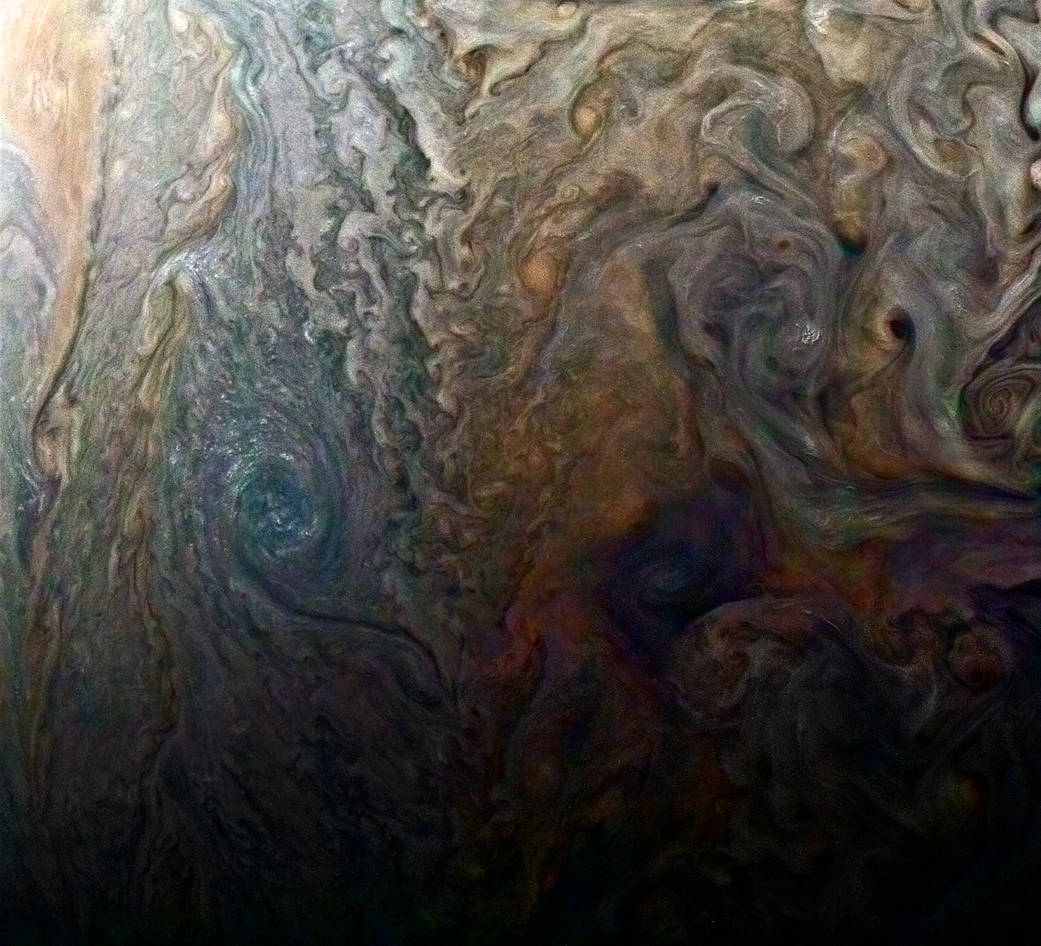
Enhanced color view from Juno’s previous flyby on Feb. 2, 2017. Image Credit: NASA/JPL-Caltech/SwRI/MSSS/Roman Tkachenko
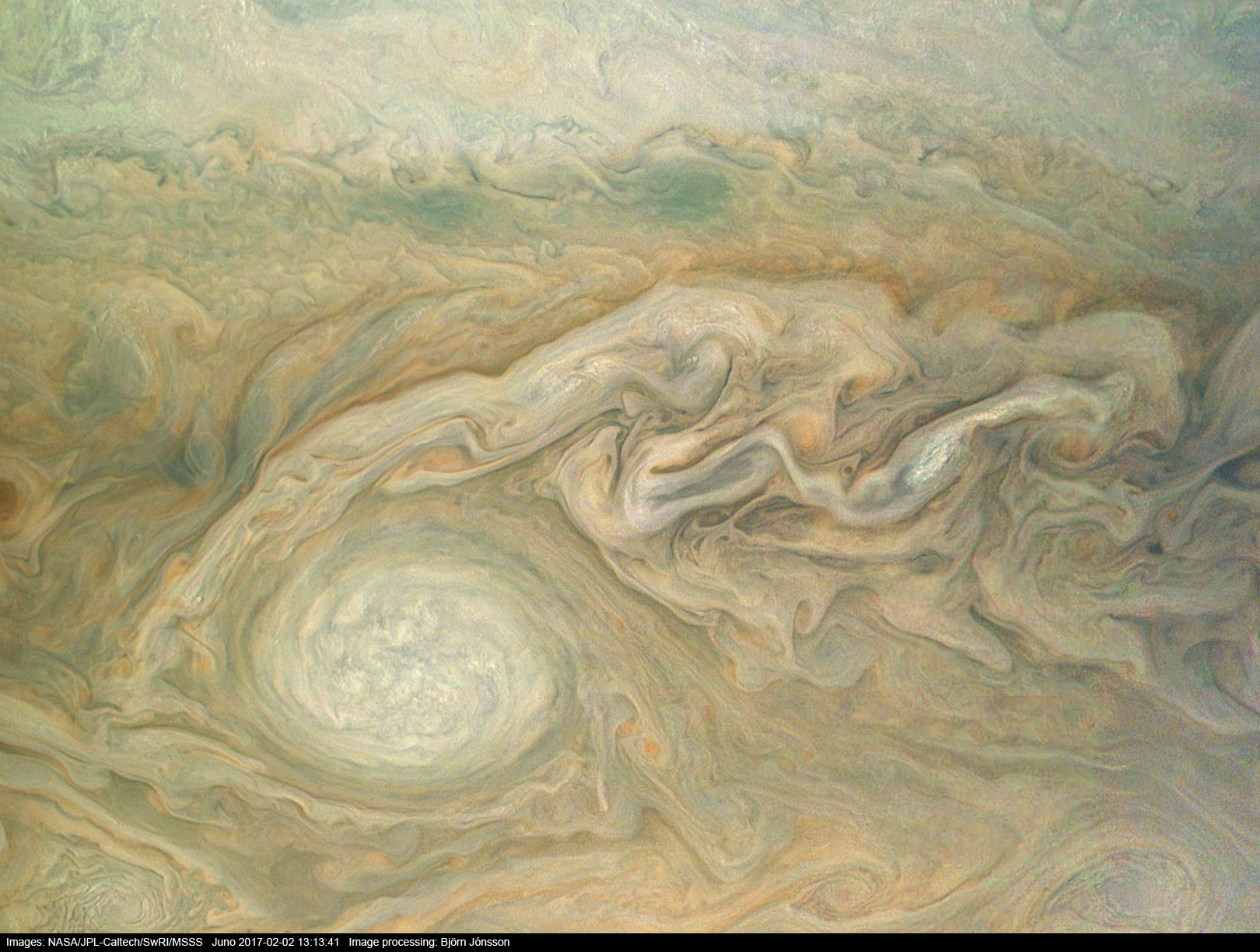
Intricate cloud formations in Jupiter’s atmosphere, from Juno’s previous flyby on Feb. 2, 2017. Image Credit: NASA/JPL-Caltech/SwRI/MSSS/Björn Jónsson
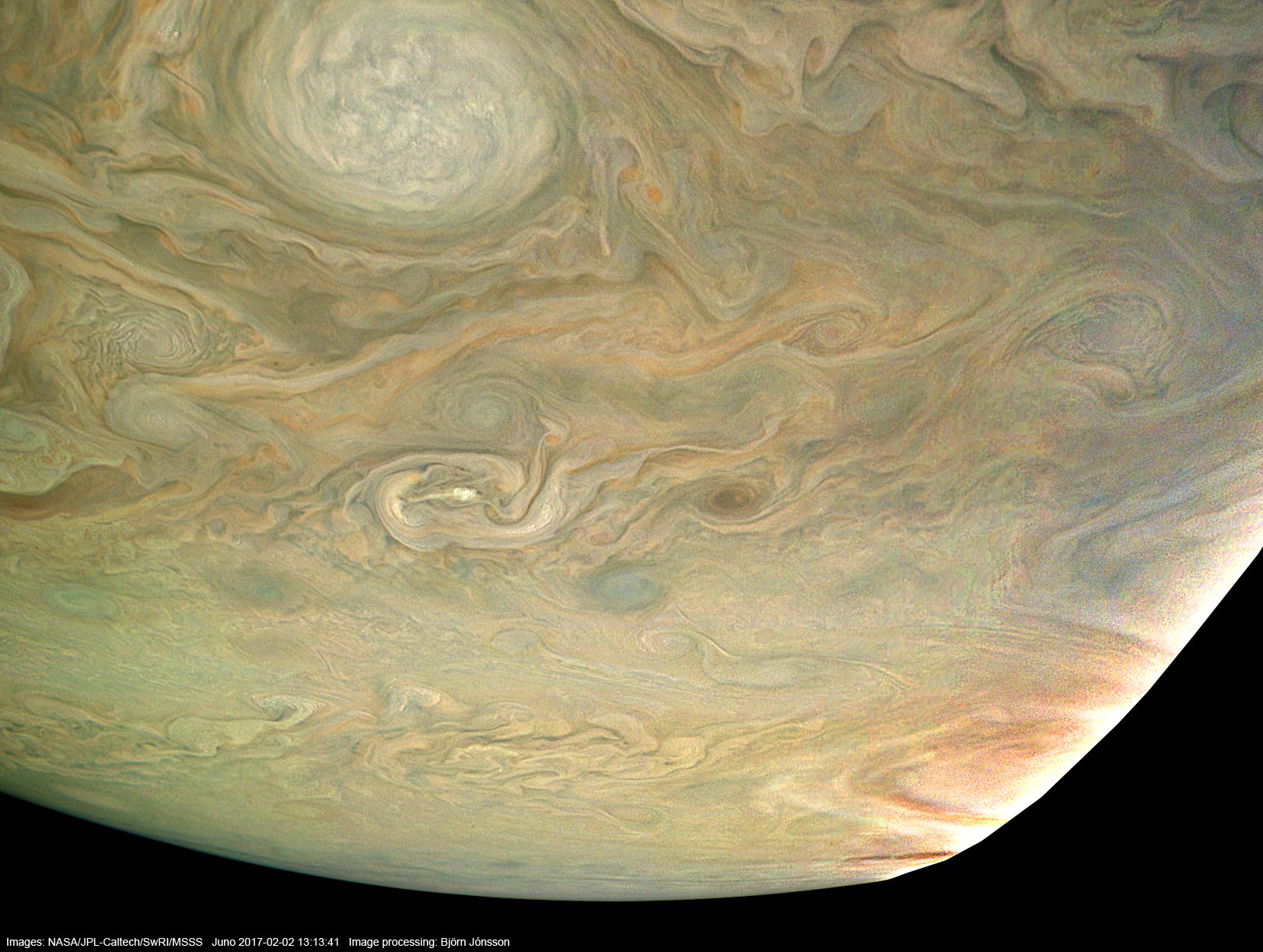
Intricate cloud formations in Jupiter’s atmosphere, from Juno’s previous flyby on Feb. 2, 2017. Image Credit: NASA/JPL-Caltech/SwRI/MSSS/Björn Jónsson
Juno’s findings so far include the fact that the distinctive “belts” in the clouds are not just a “surface” feature, but rather they actually extend deep down into Jupiter’s thick atmosphere. Juno has also found that Jupiter’s magnetic fields and aurora are larger and more powerful than previously thought. Using its Microwave Radiometer (MWR) instrument and its largest antenna, Juno can “see” about 215 to 250 miles (350 to 400 kilometers) below the top cloud deck, which essentially is still just a scratch, since Jupiter doesn’t have a solid surface per se, the atmosphere just keeps getting more and more dense the farther down you go.
“Juno is providing spectacular results, and we are rewriting our ideas of how giant planets work,” said Bolton. “The science will be just as spectacular as with our original plan.”
Unlike previous missions, Juno’s orbit takes it repeatedly over Jupiter’s poles, which is why there have been so many amazing images of those regions. Other spacecraft, such as Galileo and Voyager, have glimpsed the poles, but not in the detail that Juno has. Juno first arrived at Jupiter on July 4, 2016, and will conduct a planned series of 37 close flybys to investigate the existence of a possible ice-rock core, determine the amount of global water and ammonia present in the atmosphere, study convection and deep wind profiles in the atmosphere, investigate the origin of the Jovian magnetic field, and explore the polar magnetosphere.
Quelle: AS
---
Update: 4.05.2017
.
First results from Jupiter probe show huge magnetism and storms

NASA/JPL-Caltech/SwRI/MSSS/John Landino
Big planets come with big surprises. Last week, delegates at the annual European Geosciences Union meeting got the first glimpse of data from the Juno spacecraft now in orbit around Jupiter, and the findings are already challenging assumptions about everything from the planet’s atmosphere to its interior.
“The whole inside of Jupiter is just working differently than our models expected,” said mission principal investigator Scott Bolton of the Southwest Research Institute in Texas.
Launched on 5 August 2011, Juno reached Jupiter and began its first orbit on 4 July last year. Since then, it has performed four more circuits. There are 33 planned pole-to-pole circuits in all, encircling the entire planet bit by bit.
The findings presented in Vienna come from these first few circuits, which each last 53 Earth days and include a 6-hour scan of the planet from north to south. Although the information is preliminary, the researchers involved are thrilled.
Ammonia weather, fuzzy core
Much of the excitement centres on the discovery of a dense zone of ammonia gas around Jupiter’s equator, plus other regions where ammonia is depleted, which together suggest an ammonia-based weather system. We have long known that Jupiter is completely shrouded in ammonia clouds, but the existence of such a deep “belt” is surprising.
“We’ve known there’s a spike at the equator, but the new microwave data is showing that the spike goes way, way down into the abyss, 300 kilometres below the cloud,” says Leigh Fletcher of the University of Leicester, UK, who was not involved in the work. “It suggests ammonia is being distributed by a weather system that penetrates much deeper than anyone expected.”
The findings are also challenging models of what’s inside the planet. We had assumed Jupiter has a uniform interior, with a shallow “crust” of liquid hydrogen overlying a thin layer where helium rains down. Under that is a much deeper layer of metallic hydrogen, with a smaller solid core around 70,000 kilometres down. Those assumptions were based on mapping the planet’s gravity.
But initial gravity measurements from Juno challenge the idea that the internal layers inside are completely regular in their make-up. “Jupiter’s molecular envelope is not uniform,” said Tristan Guillot of the University of the Cote d’Azur in France. “We assumed we could treat the envelope as global, but now, with the finer data, it appears less regular.”
Fletcher says it points to a core that is not solid like Earth’s, but “fuzzy” and dilutely mingled with the overlying metallic hydrogen layer.
Massive magnetism
Another shock is that Jupiter’s huge magnetic field is even stronger and much more irregular than expected. The irregularity of the field so far is a sign that the dynamo driving it may originate higher up in Jupiter’s interior, perhaps from a layer of metallic hydrogen.
“I didn’t expect all the theories to be wrong, but there’s motion going on in the planet we did not anticipate,” Bolton said.
Jupiter’s magnetic field also dwarfs the 0.25 to 0.65 gauss at Earth’s surface by an even bigger margin than we expected. Juno readings on its closest approaches so far, presented by Jack Connerney of the NASA Goddard Space Flight Center in Maryland, suggest it could be 8 to 9 gauss rather than the 5 gauss predicted.
More tantalisingly, Juno’s magnetometers found that the field dipped in other regions, a telltale sign that the dynamo driving the field is close to the surface over the entire planet, not buried deep within it like Earth’s core.
“Jupiter’s magnetic field is spatially complex, and there were deficits of up to 2 gauss elsewhere,” said Connerney. “We may need many more orbits to resolve this.”
Earth-sized cyclones
The first orbits have also produced several new insights into the planet’s atmosphere. The probe’s JunoCam camera has already sent back amazing pictures of hitherto unknown cyclones over the poles.
Glenn Orton of the Jet Propulsion Laboratory in Pasadena, California, who helps manage the JunoCam website, showed stunning composite videos of the cyclones swirling. “They’re the size of Earth, or maybe half an Earth,” Orton told New Scientist. “They’re probably composed of condensed ammonia.”
Strange white ovals have been spotted, too, in belts south of Jupiter’s equator. They could be clouds containing ammonia and hydrazine, a substance used as rocket fuel on Earth, according to an analysis of Juno infrared radiation readings presented by Alberto Adriani of the Institute for Space Astrophysics and Planetology in Rome.
Adriani also presented stunning infrared images of the auroras which occur daily at the poles. His analyses revealed that the areas where they glow are composed mainly of methane and an ion containing three hydrogen atoms (H3+), at temperatures ranging from 500 to 950 kelvin. Adriani’s composite movies of the auroras – not released to the public yet – were equalled by others showing similar features imaged with ultraviolet spectrometers, presented by Bertrand Bonfond of the University of Liège in Belgium.
The camera is proving tougher than expected, too. Fears that it would last just a dozen circuits because of the battering from Jupiter’s intense radiation have turned out to be misplaced. “The good news is radiation damage so far is almost negligible, so it will operate for many years,” Orton said.
And more data will arrive after the next closest approach on 19 May. Eventually, Juno will fly over Jupiter’s famous Great Red Spot, and Fletcher is excited about the data that will generate. “It means that for the first time, we can go down deep and find out what’s going on underneath,” he says.
Quelle: NewScientist
---
Update: 6.05.2017
.
This enhanced color view of Jupiter’s south pole was created by citizen scientist Gabriel Fiset using data from the JunoCam instrument on NASA’s Juno spacecraft. Oval storms dot the cloudscape. Approaching the pole, the organized turbulence of Jupiter’s belts and zones transitions into clusters of unorganized filamentary structures, streams of air that resemble giant tangled strings.
The image was taken on Dec. 11, 2016 at 9:44 a.m. PST (12:44 p.m. EST), from an altitude of about 32,400 miles (52,200 kilometers) above the planet’s beautiful cloud tops.
+++
This enhanced color Jupiter image, taken by the JunoCam imager on NASA’s Juno spacecraft, showcases several interesting features on the apparent edge (limb) of the planet.
Prior to Juno’s fifth flyby over Jupiter’s mysterious cloud tops, members of the public voted on which targets JunoCam should image. This picture captures not only a fascinating variety of textures in Jupiter’s atmosphere, it also features three specific points of interest: “String of Pearls,” “Between the Pearls,” and “An Interesting Band Point.” Also visible is what’s known as the STB Spectre, a feature in Jupiter’s South Temperate Belt where multiple atmospheric conditions appear to collide.
JunoCam images of Jupiter sometimes appear to have an odd shape. This is because the Juno spacecraft is so close to Jupiter that it cannot capture the entire illuminated area in one image—the sides get cut off.
Juno acquired this image on March 27, 2017, at 2:12 a.m. PDT (5:12 a.m. EDT), as the spacecraft performed a close flyby of Jupiter. When the image was taken, the spacecraft was about 12,400 miles (20,000 kilometers) from the planet.
This enhanced color image was created by citizen scientist Bjorn Jonsson.
Quelle: NASA

